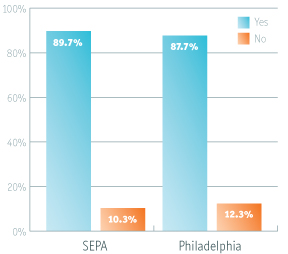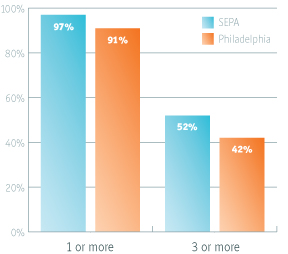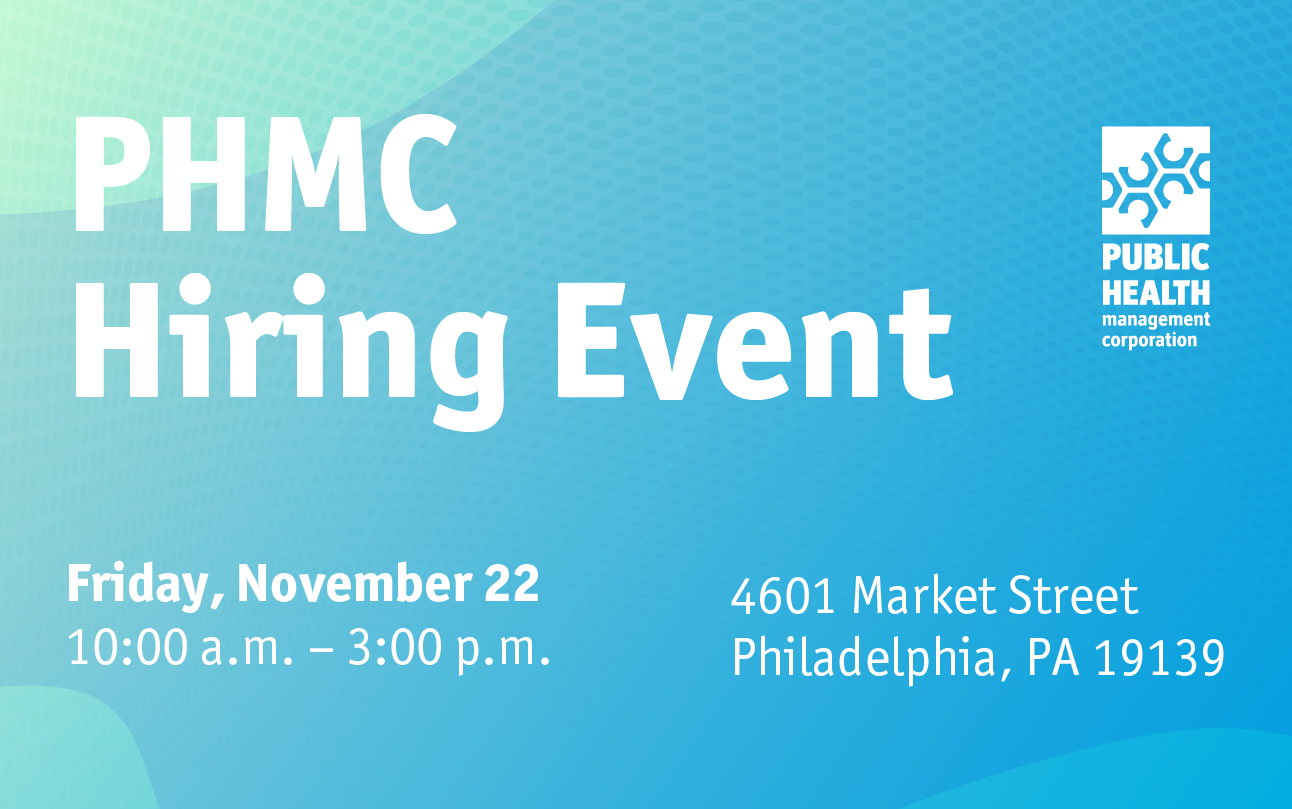Public Health Directions: Winter 2012 - 2013
Health research often highlights the negative. What are people not doing to safeguard their health? Who isn’t getting care? Where are we going wrong? While the importance of examining health disparities cannot be dismissed, in this issue of Public Health Directions we focus on the positive health data compiled by PHMC’s Community Health Data Base (CHDB). In 2010, CHDB conducted its biennial regional telephone survey examining the health, well being and healthcare experiences of more than 10,000 residents of Bucks, Chester, Delaware, Montgomery and Philadelphia Counties. CHDB found indications that many people are choosing to eat healthy, quit smoking and take other positive steps to increase their overall health and fitness.
Figure 1. Percentage of Philadelphia Adults Who Reported Excellent, Very Good, or Good Health, by Neighborhood

Adults who have a regular source of care:
- In Southeastern Pennsylvania (SEPA), nearly 90% (approximately 2,691,000) of adults report that they do have a regular source of care.
- In Philadelphia, about 88% (approximately 991,400) of adults report the same.
Figure 2. Adults Who Have a Regular Source of Care, SEPA, 2010

Adults who exercise three times or more per week:
- In SEPA, 60% (approximately 1,800,000) of adults exercise three or more days per week.
- In Philadelphia, 58% of adults (approximately 655,900) exercise three or more days per week.
- Across age groups, 62% (approximately 263,300) of adults ages 18 to 39 exercise three or more days, 57% (approximately 140,800) of those who are 50 to 59 years of age exercise three or more days, and about half (51% or approximately 50,100) of adults 75 years or older exercise three or more days per week.
Adults who do not smoke:
- In SEPA, 80% (approximately 2,383,900) of adults do not smoke.
- In Philadelphia, 75% (approximately 841,500) of adults do not smoke.
- Older adults in Philadelphia are less likely to smoke. Of those who are 75 years or older, 92% (approximately 89,400) do not smoke.
Adults who quit smoking:
- In SEPA, of those individuals who have smoked 100 or more cigarettes in their lives and no longer smoke, 91% (approximately 695,500) quit more than one year ago and still do not smoke. Nine percent (approximately 66,500) quit within the past year.
- In Philadelphia, of those who smoked at least 100 or more cigarettes in their lives and no longer smoke, 88% (approximately 220,500) have quit for longer than one year. Twelve percent quit within the past year (approximately 30,300).
Adults who report excellent, very good or good health:
- In SEPA, 84% (approximately 2,512,700) of adults report their health status as excellent, very good or good.
- In Philadelphia, 77% of adults (approximately 873,200) report their health status as excellent, very good or good.
- Younger adults have a higher percentage of excellent, very good or good health status compared with those of older adults. Ninety percent (approximately 375,600) of those 18 to 39 years of age report their health status as excellent, very good or good compared with 65% (approximately 64,600) of those who are 75 years of age or older.
Adults who eat servings of fruits and vegetables:
- In SEPA, 97% (2,827,856) of adults eat one or more servings of fruits and vegetables per day. Fifty-two percent of adults (approximately 1,502,900) in SEPA eat three or more servings of fruits and vegetables.
- In Philadelphia, 91% (1,031,230) of adults eat one or more servings of fruits and vegetables per day. Forty-two percent (approximately 459,300) of adults eat three or more servings of fruits and vegetables.
Figure 3. Number of Servings of Fruits and Vegetables Eaten Per Day, SEPA, 2010

Adults who saw a dentist in the past year:
- In SEPA, 70% (approximately 2,086,000) of adults have been to the dentist within the past year.
- In Philadelphia, 61% (approximately 682,800) of adults have been to the dentist in the past year.
Honors, Awards and Achievements
On September 20, Metropolitan Area Neighborhood Nutrition Alliance (MANNA) honored Richard J. Cohen, PhD, FACHE, PHMC’s president and chief executive officer, at the MANNA Nourish Awards Luncheon. The annual event recognizes champions in the health care and nutrition fields.
In October, PHMC employee Eudora Burton was named a Local Hero by WHYY’s NewsWorks. Burton is a social services specialist for Opening Doors, a PHMC program initially funded by the Pew Foundation and currently supported by the United Way of Greater Philadelphia and Southern New Jersey. Opening Doors provides supports to PHMC affiliate National Nursing Centers Consortium’s Nurse-Family Partnership, the Philadelphia branch of a national nonprofit organization that provides first-time, low-income mothers with a public health nurse home visiting program. Burton helps mothers increase their knowledge and skills to secure safe, affordable housing for their families.
On July 1, Amy Miller, formerly the school director of Metropolitan Career Center’s (MCC) Community Technology Institute (CTI), was promoted to executive director of MCC. Miller has worked at MCC/CTI for the last 10 years. She received her bachelor’s degree from LaSalle University and her master’s degree in education from Holy Family University.
Health Promotion Council’s (HPC) Executive Director and PHMC Managing Director of Health Promotion Vanessa Briggs, HPC Deputy Executive Director Tinesha Banks and PHMC Research and Evaluation Group Senior Research Associate Caroline West were among the six authors of an article published in the August issue of the Journal of Asthma. “Asthma Prevalence in Philadelphia: Description of Two Community-Based Methodologies to Assess Asthma Prevalence in an Inner-City Population” examined “the local prevalence of asthma in Philadelphia communities and schools of low-income, disadvantaged children utilizing a grassroots approach that would access traditionally hard-to-reach families,” according to the publication.
On October 22, Yahoo News featured Community Health Data Base (CHDB) data on children and obesity, yielding national attention in an article about how greater parental stress is linked to children’s obesity, fast food consumption and reduced physical activity. CHDB has served the information needs of hundreds of organizations in Southeastern Pennsylvania (SEPA) by providing up-to-date and reliable community-level health and social service data. CHDB’s central component, the Southeastern Pennsylvania Household Health Survey, is one of the largest local health surveys in the country. To read the Yahoo News article in full, click here.
PHMC’s Neil Goldfarb is one of the authors of “Measuring Migraine-Related Quality of Care Across 10 Health Plans” in the August issue of The American Journal of Managed Care. The article features results from a study on migraine care conducted by Goldfarb and his colleagues during Goldfarb’s former position with Jefferson School of Population Health. Goldfarb now serves as executive director of PHMC’s Greater Philadelphia Business Coalition on Health, which launched in January 2012.
Grants
The Barra Foundation Community Fund awarded Interim House a grant of $2,000 in August toward general operating costs. Interim House provides a continuum of comprehensive services to women addicted to drugs and alcohol. This is the third consecutive year that Interim House received funding from the foundation.
The E3 Center West received a $13,000 capacity expansion grant from Philadelphia Youth Network. The West Philadelphia-based E3 Center, operated by The Bridge, an affiliate of PHMC, gives teens who have dropped out of school or are involved with the juvenile justice system new opportunities for education and employment training.
In October, The Philadelphia Foundation awarded $36,000 for the coming fiscal year to PHMC affiliate Joseph J. Peters Institute (JJPI), a nonprofit mental health agency providing outpatient assessment and treatment services in the area of sexual abuse. The grant recognizes JJPI as a “high-performing nonprofit organization at the Mission Impact life-cycle stage.” The grant is awarded from the Edward M. Story Memorial Fund in memory of his father, Samuel Story, and his mother, Mary Grosvenor; the Henry Griffith and Anna Griffith Keasbey Fund; the William M. and Helen M. Detwiler Memorial Fund; and the William J. McCahan 3rd Fund in memory of Thomas C. McCahan and Florence M. McCahan.
New Developments
As the role of data in health and human services, policy and business continues to grow, PHMC is pleased to announce the new PHMC Center for Data Innovation. Scheduled for a February 2013 rollout, the center will feature refined data collection technologies and tools to improve accessibility and timeliness of critical data to help organizations make better decisions and plan more effective programs.
 In June 2012, 25 teens gathered in a small conference room at PHMC’s 260 South Broad Street location to talk about their dreams. One spoke of wanting to travel the world. Another hopes to start his own restaurant. Yet another mentioned wanting to attend medical school after college. Over the summer, these teens got the opportunity to jump-start their career readiness with jobs at PHMC that provided them with real-world experience.
In June 2012, 25 teens gathered in a small conference room at PHMC’s 260 South Broad Street location to talk about their dreams. One spoke of wanting to travel the world. Another hopes to start his own restaurant. Yet another mentioned wanting to attend medical school after college. Over the summer, these teens got the opportunity to jump-start their career readiness with jobs at PHMC that provided them with real-world experience.
In April 2012, Deborah McMillan, Elaine Colbert and Rachael Kirzner, of PHMC's social services, received funding for PHMC from Philadelphia Youth Network to bring the WorkReady program to PHMC. “Our hope is that the teens can use this experience as a launch-pad for their goals, careers and futures,” says McMillan. A video the teens created shows that they are well on their way.
Preparation and planning for WorkReady began in April to ensure that the program would operate smoothly. Through WorkReady, which kicked off with orientation in June, students received a range of potential positions. Colbert, who works with 100 Philadelphia school students every year, selected the students who worked at PHMC and matched them to their jobs based on interests and talents. “A few students needed a second chance, most needed a first chance. But I knew all of them would benefit from it,” she recalls. Through collaboration with Melissa Fox, PHMC’s managing director of health, who reached out to senior administrators at PHMC, 80 percent of the students were placed at PHMC’s headquarters on South Broad Street in Philadelphia while the remainder worked at its New Pathways Projects, HELP Philadelphia, Mary Howard Health Center, Rising Sun Health Center, Metropolitan Career Center and Urban Garden project locations. “We created a microcosm of what working in the real world would be like,” says McMillan.
On Fridays, the teens gathered together for workshops that provided helpful workplace preparation advice for students, from interviewing skills to professional attire. “The WorkReady program gave youth the opportunity to see what the workforce is about, learn 21st-century work skills, meet people and be around positive people who gave guidance and hope,” says Colbert. “I’m positive that everyone learned something.”
At the conclusion of the program in early August, the students presented a video documenting their experience, created under the guidance of several college students, also participants in the program, who assumed leadership roles among the teens. It features interviews with the students and their supervisors. “I’ve seen the youth become more mature, self-confident, outgoing and more comfortable in the workplace setting,” says Colbert. “The video definitely expressed that.”
Click here to watch clips from the WorkReady students's video.
Sissy Troy, a WorkReady teen who held a summer position with the PHMC Communication team, contributed to this article.

In September, several of my colleagues and I led members of the PHMC board of directors on a half-day tour of some of PHMC’s programs. In that limited time, we could only visit a few sites.
We stopped in at Interim House West, PHMC Care Clinic, CHANCES and Mary Howard Health Center. Our board members, however long their tenure, reported that these brief visits gave them a more intimate understanding of and connection to PHMC than anything that happens at meetings or that they read in our literature or comprehensive reports.
There is plenty we can say about Public Health Management Corporation, and we do spend a lot of time and energy talking about our impact and accomplishments with our stakeholders. But nothing speaks for our work better than seeing it. So we dedicate this issue of Public Health Directions to helping you to see PHMC.
In fact, PHMC communicates more and more through visual media. We now have a video channel on Philly In Focus, and we invite you to link to it here. We have developed new partnerships to help us increase our development of videos to share our programs’ and affiliates’ messages and reach our audiences. Our photography library grows constantly, allowing us to show you how and whom we serve.
Throughout this issue, you’ll find that we share those images or provide links to visual media such as websites, videos and TV interviews. We show you how the exteriors of our health centers are much more than window dressing, but an outward expression of the integrated network that allows us to serve patients more effectively. Read about the grant that our affiliate Public Health Fund awarded to help create a huge public art installation and educational tool about air pollution.
While that artwork will hold an imprint on Philadelphia for just three months, our story on page three focuses on much more permanent additions to the city’s landscape. Several new construction projects are allowing us to expand services and, as our architectural renderings show, provide aesthetically uplifting environments for our clients.
Thank you for letting us show you PHMC. Our impact looks so good because of the support and dedication of our employees, partners and funders. We deeply appreciate all that you do.
Yours in public health,
![]()
Richard J. Cohen, PhD, FACHE
President and CEO of PHMC





